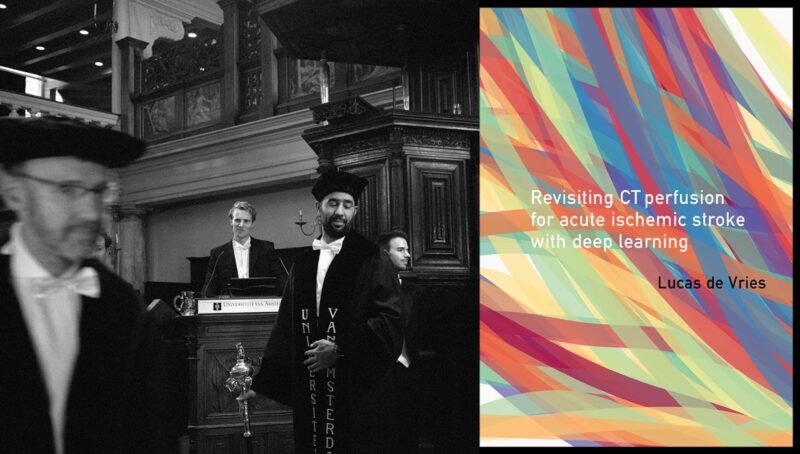
Lucas de Vries Defends His PHD Combining Physics, Deep Learning and Medical Imaging
Lucas de Vries, PhD Candidate Deep Learning for Neuroradiology at Amsterdam UMC, shared on LinkedIn:
”On October 1st, I defended my PhD thesis, ‘Revisiting CT perfusion for acute ischemic stroke with deep learning’.
I’m happy to share that I have now officially obtained my PhD.
In my thesis, I explored how we can combine physics, deep learning, and medical imaging.
Specifically, I investigated how physics-informed deep learning can improve the analysis of dynamic CT perfusion imaging for acute ischemic stroke.
The full thesis is available online (see the comments below) and is based on the following five publications:
– PerfU-Net: Baseline infarct estimation from CT perfusion source data for acute ischemic stroke (Medical Image Analysis)
– Spatio-temporal physics-informed learning: A novel approach to CT perfusion analysis in acute ischemic stroke (Medical Image Analysis)
– Accelerating physics-informed neural fields for fast CT perfusion analysis in acute ischemic stroke (MIDL)
– Neural fields for tissue attenuation curve reconstruction in sparsely sampled time-resolved CT (MIDL)
– Automated collateral assessment restricted to the hypoperfused area for distal vessel occlusions in ischemic stroke (European Radiology)
A big thanks to my team, Efstratios Gavves, Henk Marquering, Charles Majoie, and Bart Emmer, for their guidance over the past few years, to all my co-authors, and to my paranimfs Julius de Vries and Roel van Herten for their endless support.
With this chapter coming to an end, I will soon be moving to Paris to start a new adventure.
If you are based in Paris or have connections there, I would appreciate any recommendations or introductions, whether related to housing, research, machine learning, or just meeting new people.
Always happy to grab a coffee and connect!”
Read the full article here.
Article: Revisiting CT perfusion for acute ischemic stroke with deep learning
Authors: Lucas de Vries

Stay updated with Hemostasis Today.
-
Oct 30, 2025, 12:12Laura Ceci Galanos Reflects on WSC 2025
-
Oct 30, 2025, 03:53Michael Makris on Biomarin's Decision to Divest Roctavian
-
Oct 29, 2025, 10:39UMR1011 Researchers at ECTH 2025
-
Oct 29, 2025, 07:09Hritvik Jain and Andrew Goldsweig Sharedrisk About the Risk of MACCE, AMI, and readmission in IBD patients undergoing PCI
-
Oct 29, 2025, 07:07Flora Peyvandi Shared an Article About Menstrual Bleeding and Bleeding Tendency in Dutch Adolescents
-
Oct 30, 2025, 05:14Umberto Pensato on Reperfusion Outcomes in Stroke
-
Oct 29, 2025, 07:18Osimertinib Has Transformed Lung Cancer Care — But at What Cost to the Heart?
-
Oct 29, 2025, 07:15From the Lab to Prague․ Our ECTH 2025 Experience
-
Oct 29, 2025, 07:13Amol Akhade: Happy To Share Our Paper Published In Lancet Oncology
-
Oct 29, 2025, 07:09Davide Capodanno: This Time It’s About the Timing of Complete Revascularization in ACS
-
Oct 29, 2025, 07:05Shrinidhi Nathany: AI in Diagnostic Medicine
-
Oct 28, 2025, 07:02Aya Berman: AI Model for Predicting Bacteremia
-
Oct 28, 2025, 06:55The New Era of Genomics, AI and Cell Therapy in Hematology and Infectious Diseases
-
Oct 28, 2025, 06:49Lukas Gaats: Researchers Are Building Reproductive Organoids
-
Oct 27, 2025, 09:19Mitra Najafi: Digital Storage Device - Specifically Designed and Developed to Store and Preserve PRP
-
Oct 30, 2025, 11:56Lucas de Vries Defends His PHD Combining Physics, Deep Learning and Medical Imaging
-
Oct 30, 2025, 03:50Laura Bouvet Receives the Young Investigator Award at ECTH 2025
-
Oct 29, 2025, 08:30ECTH 2025․ Advancing the Science of Thrombosis and Haemostasis Together
-
Oct 28, 2025, 06:59Wim van den Broek Attended ECTH in Prague
-
Oct 28, 2025, 06:46Alexandre Kauskot Attended ECTH in Prague
